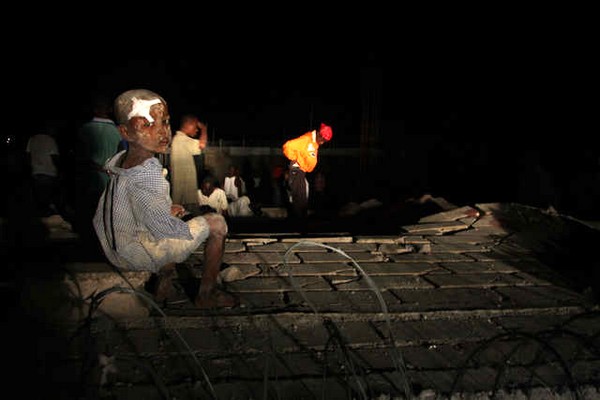
Not yet having overcome the gray and cold, with little bread and scant shelter, which we Cubans have passed through in these days of January 2010, news of the earthquake in Haiti came to us.
With the passing of the hours, we learned the magnitude of the catastrophe, a tragedy that grows daily. The entire world mobilized, but as a consequence of the chaos and the lack of infrastructure, the airport and port facilities in Port-au-Prince that are insufficient for the number of planes and ships coming from five continents bringing every king of humanitarian aid. The faster they can arrive, by air and by sea, the more lived can be saved.
Once more, disaster falls on Haiti. Not because they are black or the descendents of Africans. The evil in Haiti is not of this origin. Given their history of struggle for emancipation from slavery and freedom, they should be one of the most prosperous nations in the Caribbean. However, for more than two centuries, Haiti has been bleeding.
If today it is the poorest country on the American continent and one of the poorest in the world, it is because of the successions of misgovernment. Ungovernability summarized in two words: repression and corruption.
Dictators and incompetent leaders are to blame for the backwardness and evil current endured by the Haitian people. Illiteracy and unemployment have been a breeding ground for the emergence of gangs, machete in hand, who perpetrate violence, theft and crime, all common in the streets and neighborhoods.
A share of the guilt also belongs to its neighbors in the Americas, the closest and the furthest, like the United States, who when not intervening to support coups d’etat, preferred to look away and block their ears.
Better late than never. Now, we’re grateful that President Barack Obama has made Haiti a White House priority. A decision supported by the generous response of the American people, poor and rich, anonymous and famous, atheists and believers, civilian and military.
Let us leave Washington and return to Havana. The truth is, of the few nations in the region who have always stood by Haiti, we find Cuba. It’s logical.
We share more than 200 years of geographic, historic, cultural and ethnic background. The veins of thousands of Cubans run with the blood of Haitians, especially the people of Guantánamo, Santiago de Cuba and Camagüey, three of the provinces where there are major Haitian communities, and whose children, grandchildren and great-grandchildren keep alive the language, music, religions, food and other traditions.
Many of these Haitians or their descendants achieved fame on the Island. It is impossible to mention them all and therefore we have chosen one name, that of Martha Jean-Claude. With her we pay tribute to all the Haitians who have made Cuba their homeland.
When the earthquake struck, around 5:00 in the afternoon on Tuesday, January 12, more than 400 Cuban helpers, mostly doctors and nurses, were already in Haiti. To date, only three Cubans have been reported injured, two mildly and one seriously.
The love story between Brazil and Haiti is more recent. It began in 2004, when under UN mandate, Brazil assumed responsibility for coordinating the United Nations Mission for the Stabilization of Haiti (MINUSTAH). Brazilian president Lula made that responsibility his own, and many Brazilians began to get involved. And as happens in the fairy tales, for a few hours everyone was happy. In 2005, when the Brazilian National Football (Soccer) Team went to play a friendly match in Haiti, the video shows what happened:
Despite the critical economic situation in Cuba and the deteriorating living and nutrition standards of a great part of our population, many Cubans, according to man-on-the-street opinions, would be willing to go to Haiti to help in the reconstruction. A so urgent and necessary work that at this time, against the clock, is being done by volunteers, firefighters, rescue workers and sniffer dogs from Mexico, Spain, Japan and China among other countries with considerable experience in earthquakes and natural disasters.
So far, three pieces of good news were announced on Friday, January 14. The Department of Homeland Security in the U.S. reported that Obama granted temporary resident status (TPS) to all undocumented Haitians in its territory, allowing them to reside and work in the United States for 18 months.
For its part, the Cuban Ministry of Foreign Affairs declared that the Island was ready to cooperate with all countries, including the United States, to help save lives in this emergency situation. Showing this was more than mere words, the Cuban authorities announced they had authorized U.S. planes to fly over the eastern territory of the country, to evacuate the wounded from Haiti to the Guantanamo Naval Base, where there is a hospital. This authorization saves 90 minutes of flying time.
The third piece of good news came from Port-au-Prince. The heroes were two Spanish firefighters who rescued a two-year-old Haitian boy whose photograph circumnavigated the globe.
Along with this good news, a rumor circulating for some days in Havana was confirmed, that some twenty mentally ill patients had died in the Psychiatric Hospital commonly knows as Mazorra, located in Rancho Boyeros, where the thermometers had fallen to 4 degrees Celsius.
The terrible event, that had been publicized by the dissident National Commission for Human Rights and National Reconciliation, was confirmed by the Minister of Public Health.
There were 26 dead. A true scandal. People are shocked and hope that those guilty of such negligence will face trial. And that the response will not be limited to distributing blankets, clothes and food with more calories. Cubans want, once and for all, to free Mazorra from the Dante-esque fame it has always had.
Returning to Haiti. Among so many dead and such ruins, we are sure that the green grass of hope will begin to sprout.
Iván García and Laritza Diversent
Photo: Chicago Red Cross, Flickr
